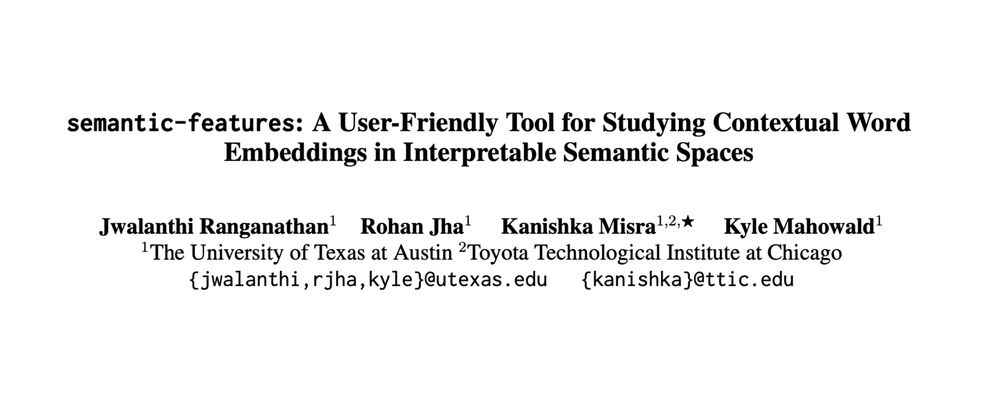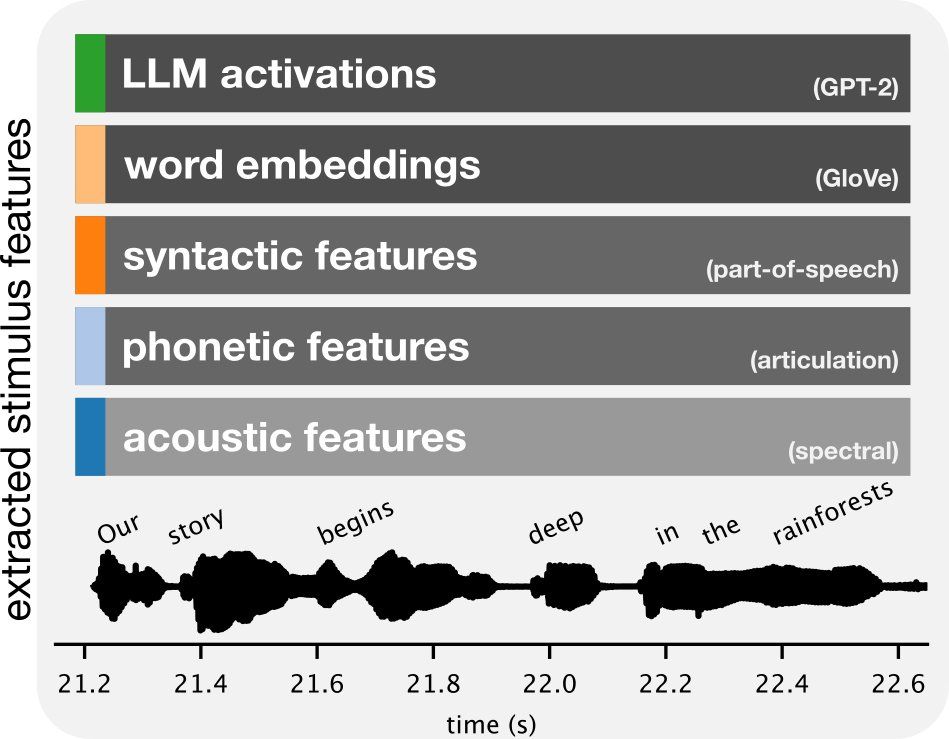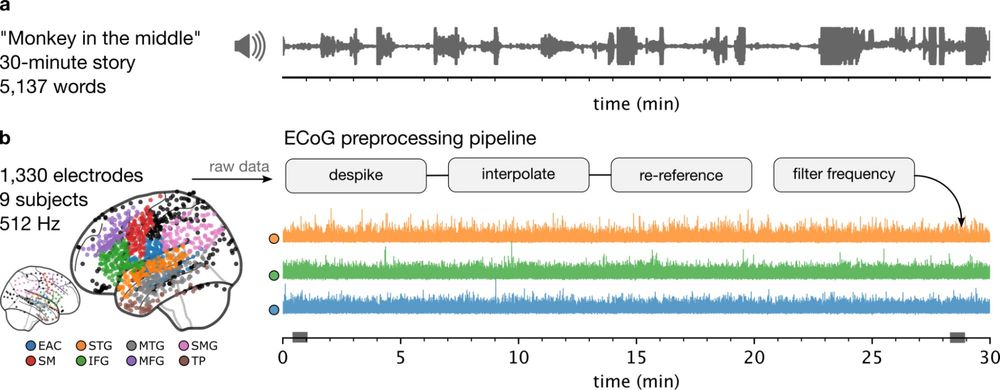
A figure demonstrating the different aspects of the corpus described in the tweet. There is a main isomorphic 3D view of a level in the Portal 2 co-op game, with some portals, lasers, and the blue and orange players. Inset, there are first-person captures of the blue and orange player views. There is also a box containing the transcribed dialogue with timestamps and labels for the discursive acts. Finally, there is a box containing a task and a list of subtasks. Some subtasks are already crossed out, with the time that they have been completed. The last subtask ("Player 2 places portal 4 on wall 4") is marked incomplete.
The dialogue is as follows:
Blue: Can you put your other portal up here? (tagged as directive)
Orange: Where? (tagged as request for clarification)
Blue: On uh, on this wall. (tagged as directive)
Blue: So that it uh points at the circle. (tagged as directive)
Orange: Okay. (tagged as commit)
The full list of subtasks is:
Task: Redirect lasers
Subtask: Player 1 places portal 1 on wall 1. (completed)
Subtask: Player 1 polaces portal 2 on wall 2 or 3. (completed)
Subtask: Player 2 places portal 3 opposite of portal 2. (completed)
Subtask: Player 2 places portal 4 on wall 4. (incomplete)
A couple years (!) in the making: we’re releasing a new corpus of embodied, collaborative problem solving dialogues. We paid 36 people to play Portal 2’s co-op mode and collected their speech + game recordings.
Paper: arxiv.org/abs/2512.03381
Website: berkeley-nlp.github.io/portal-dialo...
1/n
05.12.2025 18:54 — 👍 100 🔁 30 💬 3 📌 8
OSF
New preprint w/ Malin Styrnal & @martinhebart.bsky.social
Have you ever computed noise ceilings to understand how well a model performs? We wrote a clarifying note on a subtle and common misapplication that can make models appear quite a lot better than they are.
osf.io/preprints/ps...
04.12.2025 18:53 — 👍 58 🔁 23 💬 1 📌 4

Investigating individual-specific topographic organization has traditionally been a resource-intensive and time-consuming process. But what if we could map visual cortex organization in thousands of brains? Here we offer the community with a toolbox that can do just that! tinyurl.com/deepretinotopy
01.12.2025 11:26 — 👍 75 🔁 36 💬 4 📌 1

🤖📈 How do LLMs use their depth?
Akshat Gupta led a fun project to find out! We leverage TunedLens (~linear decoding of tokens) to explore how LLMs' internal representations change from layer to layer.
Preprint: arxiv.org/abs/2510.18871
1/
23.10.2025 16:17 — 👍 69 🔁 16 💬 3 📌 0
I’m excited to share my recent preprint on a neural network model of free recall that learns multiple memory strategies including the memory palace!
www.biorxiv.org/content/10.1...
21.10.2025 03:36 — 👍 33 🔁 16 💬 1 📌 2
Proudly published with @andreaeyleen.bsky.social:
A metatheory of classical and modern connectionism. doi.org/10.1037/rev0...
We touch on what has been up with connectionism as a framework for computational modelling — & for everything it seems these days with AI and LLMs — pre-2010 vs post.
1/n
17.10.2025 12:53 — 👍 60 🔁 20 💬 4 📌 8
thrilled to share our preprint on false memories in naturalistic recollection!
Distinct paths to false memory revealed in hundreds of narrative recalls
paper: doi.org/10.31234/osf...
w/ phoebehc.bsky.social (co-first) Vy A. Vo @davidpoeppel.bsky.social @toddgureckis.bsky.social
thread below 👇
16.10.2025 19:29 — 👍 48 🔁 13 💬 2 📌 1

My lab at USC is recruiting!
1) research coordinator: perfect for a recent graduate looking for research experience before applying to PhD programs: usccareers.usc.edu REQ20167829
2) PhD students: see FAQs on lab website dornsife.usc.edu/hklab/faq/
28.09.2025 21:46 — 👍 40 🔁 25 💬 1 📌 1

Managing emotions is not easy - we often get by with a little help. In the NEW Social Interaction and Emotion Lab at Rutgers-Newark, we’ll study how social interactions regulate emotion using experiments, naturalistic data, and multi-modal approaches. ✨ Now recruiting! ✨🙌 Learn more: raziasahi.com
08.10.2025 19:25 — 👍 36 🔁 18 💬 2 📌 5
MIT Rejects the Compact!
I am so proud.
"The document also includes principles with which we disagree, including those that would restrict freedom of expression and our independence as an institution. And fundamentally, the premise of the document is inconsistent with our core belief ...
10.10.2025 13:35 — 👍 292 🔁 63 💬 3 📌 3

📣 New preprint from the Braga Lab! 📣
The ventral visual stream for reading converges on the transmodal language network
Congrats to Dr. Joe Salvo for this epic set of results
Big Q: What brain systems support the translation of writing to concepts and meaning?
Thread 🧵 ⬇️
07.10.2025 21:51 — 👍 58 🔁 17 💬 2 📌 1

Doctoral Program - Department of Psychology
USC Dornsife Department of Psychology
Check out the lab website for ideas about the kind of work we'll be doing: shared-minds.github.io
All admissions are through the Brain and Cognitive Science area of the Department of Psychology at USC: dornsife.usc.edu/psyc/doctora...
Feel free to reach out via email as well!
01.10.2025 22:39 — 👍 5 🔁 0 💬 0 📌 0

I'm recruiting PhD students to join my new lab in Fall 2026! The Shared Minds Lab at @usc.edu will combine deep learning and ecological human neuroscience to better understand how we communicate our thoughts from one brain to another.
01.10.2025 22:39 — 👍 119 🔁 72 💬 9 📌 3
As our lab started to build encoding 🧠 models, we were trying to figure out best practices in the field. So @neurotaha.bsky.social
built a library to easily compare design choices & model features across datasets!
We hope it will be useful to the community & plan to keep expanding it!
1/
29.09.2025 17:33 — 👍 34 🔁 6 💬 1 📌 0

Abstract: Under the banner of progress, products have been uncritically adopted or
even imposed on users — in past centuries with tobacco and combustion engines, and in
the 21st with social media. For these collective blunders, we now regret our involvement or
apathy as scientists, and society struggles to put the genie back in the bottle. Currently, we
are similarly entangled with artificial intelligence (AI) technology. For example, software updates are rolled out seamlessly and non-consensually, Microsoft Office is bundled with chatbots, and we, our students, and our employers have had no say, as it is not
considered a valid position to reject AI technologies in our teaching and research. This
is why in June 2025, we co-authored an Open Letter calling on our employers to reverse
and rethink their stance on uncritically adopting AI technologies. In this position piece,
we expound on why universities must take their role seriously toa) counter the technology
industry’s marketing, hype, and harm; and to b) safeguard higher education, critical
thinking, expertise, academic freedom, and scientific integrity. We include pointers to
relevant work to further inform our colleagues.

Figure 1. A cartoon set theoretic view on various terms (see Table 1) used when discussing the superset AI
(black outline, hatched background): LLMs are in orange; ANNs are in magenta; generative models are
in blue; and finally, chatbots are in green. Where these intersect, the colours reflect that, e.g. generative adversarial network (GAN) and Boltzmann machine (BM) models are in the purple subset because they are
both generative and ANNs. In the case of proprietary closed source models, e.g. OpenAI’s ChatGPT and
Apple’s Siri, we cannot verify their implementation and so academics can only make educated guesses (cf.
Dingemanse 2025). Undefined terms used above: BERT (Devlin et al. 2019); AlexNet (Krizhevsky et al.
2017); A.L.I.C.E. (Wallace 2009); ELIZA (Weizenbaum 1966); Jabberwacky (Twist 2003); linear discriminant analysis (LDA); quadratic discriminant analysis (QDA).

Table 1. Below some of the typical terminological disarray is untangled. Importantly, none of these terms
are orthogonal nor do they exclusively pick out the types of products we may wish to critique or proscribe.

Protecting the Ecosystem of Human Knowledge: Five Principles
Finally! 🤩 Our position piece: Against the Uncritical Adoption of 'AI' Technologies in Academia:
doi.org/10.5281/zeno...
We unpick the tech industry’s marketing, hype, & harm; and we argue for safeguarding higher education, critical
thinking, expertise, academic freedom, & scientific integrity.
1/n
06.09.2025 08:13 — 👍 3587 🔁 1827 💬 106 📌 345
I've only read the abstract and I already know this paper is so very correct 👀
14.09.2025 03:06 — 👍 73 🔁 22 💬 6 📌 0
The psych job market may not be dead... but it is gravely injured 😬 So far it's looking like the Trump administration's attacks on higher ed/research are going to have more than 2x the impact on the job market as the covid-19 pandemic. #psychjobs #neurojobs #academicjobs
03.09.2025 18:27 — 👍 165 🔁 73 💬 14 📌 10

New Open dataset alert:
🧠 Introducing "Spacetop" – a massive multimodal fMRI dataset that bridges naturalistic and experimental neuroscience!
N = 101 x 6 hours each = 606 functional iso-hours combining movies, pain, faces, theory-of-mind and other cognitive tasks!
🧵below
04.09.2025 19:21 — 👍 114 🔁 58 💬 3 📌 3
🚨 Just over a week left to register for the #CNSP2025 Online Workshop (details in post below)! 🚨
Link to the workshop registration form: docs.google.com/forms/d/e/1F...
22.08.2025 10:32 — 👍 6 🔁 7 💬 1 📌 0

The rumors are true! #CCN2026 will be held at NYU. @toddgureckis.bsky.social and I will be executive-chairing. Get in touch if you want to be involved!
15.08.2025 16:43 — 👍 172 🔁 30 💬 4 📌 6

Title page of SCIL extended abstract titled: semantic-features: A User-Friendly Tool for Studying Contextual Word Embeddings in Interpretable Semantic Spaces
I will unfortunately have to skip SCiL this year, but I am thrilled to share that Jwalanthi will be presenting this work by her, @rjha.bsky.social, me, and @kmahowald.bsky.social on a tool that allows you to project contextualized embeddings from LMs to interpretable semantic spaces!
17.07.2025 17:47 — 👍 15 🔁 4 💬 1 📌 1

Finally, we developed a set of interactive tutorials for preprocessing and running encoding models to get you started. Happy to hear any feedback or field any questions about the dataset! hassonlab.github.io/podcast-ecog...
07.07.2025 21:00 — 👍 7 🔁 2 💬 0 📌 0

We validated both the data and stimulus features using encoding models, replicating previous findings showing an advantage for LLM embeddings.
07.07.2025 21:00 — 👍 1 🔁 0 💬 1 📌 0

We also provide word-level transcripts and stimulus features ranging from low-level acoustic features to large language model embeddings.
07.07.2025 21:00 — 👍 0 🔁 0 💬 1 📌 0

We recorded ECoG data in nine subjects while they listened to a 30-minute story. We provide a minimally preprocessed derivative of the raw data, ready to be used.
07.07.2025 21:00 — 👍 1 🔁 0 💬 1 📌 0
Clinical Research Specialist at UNC Charlotte’s Violence Prevention Center • Research Fellow @ the Kinsey Institute • Gender, sexuality, and body image research • Perpetual optimist • Crossword puzzle and Mamma Mia enthusiast • She/her/hers
Psychology prof at UniMelb, co-director of MetaMelb (interdisciplinary metascience lab).
Live (mostly) in Sydney.
Study credibility of science & how to improve it.
@siminevazire on Twitter
PhD student at UT Austin. Interested in language, computers, and the brain. No thoughts about memes.
A @natureportfolio.nature.com journal on mathematical models and computational methods/tools that help advance science in multiple disciplines. https://www.nature.com/natcomputsci
Deputy editor at Foreign Policy, China nerd, gaming nerd, reads a lot
Served as 57th Chair of the Federal Trade Commission.
Postdoc @ Princeton AI Lab
Natural and Artificial Minds
Prev: PhD @ Brown, MIT FutureTech
Website: https://annatsv.github.io/
교포 입양자 KAD 🇰🇷 she/her
not a journalist. don’t be weird!
I have friends everywhere
writer/editor, member @transjournalists.org
lexmcmenamin.com
linktr.ee/lexmcmenamin
social neuro phd student @ ucla | brain basis of shared reality | she/her
I'm interested in how animals communicate with sound and I try to make that easier for everyone to study: https://www.vocalpy.org/
Cat & dog dad, cold brew addict, video gamer, Florida boy, #altac, podcast fan, occasional espanglish. nicholdav.info
Assistant Professor @ USC
Associate Professor @FuDanUniv | alumnus @IUMediaSchool@ICR_IU
Associate Editor, Cognitive Science (CSJ)
Vice Chair Elect, Information Systems, International Communication Association
https://jingjinghancomm.github.io/index.html
Cognitive Neuroscientist studying Music, Brain, and Development
Tedx Talk : https://www.youtube.com/watch?v=Xb_WjzUqY-c
Neuroscientist. Assistant Professor of Cognition and Brain Science @ GeorgiaTech Prev: Postdoc @ MIT, PhD @ IISc Bangalore
www.murtylab.com
Asst prof of psychology at the National University of Singapore | he/him
👨🔬 https://dongwonoh.com
🌐 https://oh-lab.com
🔬 @ohlab.bsky.social


























